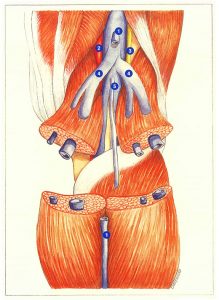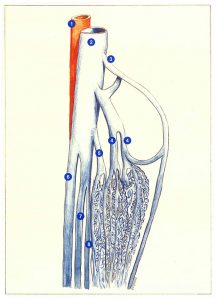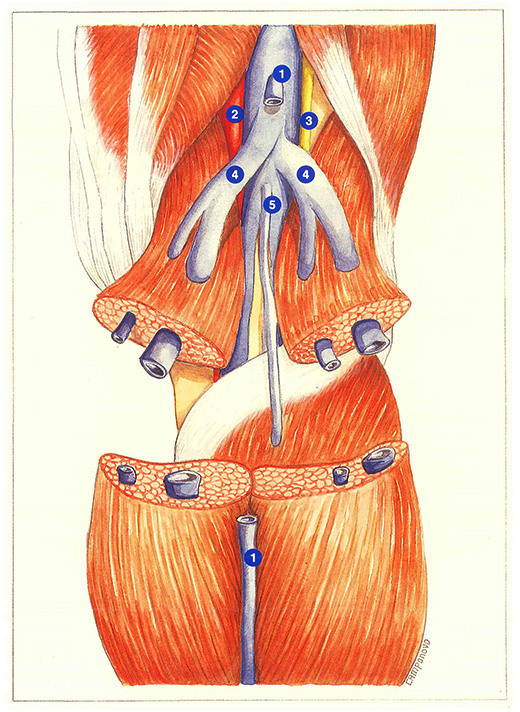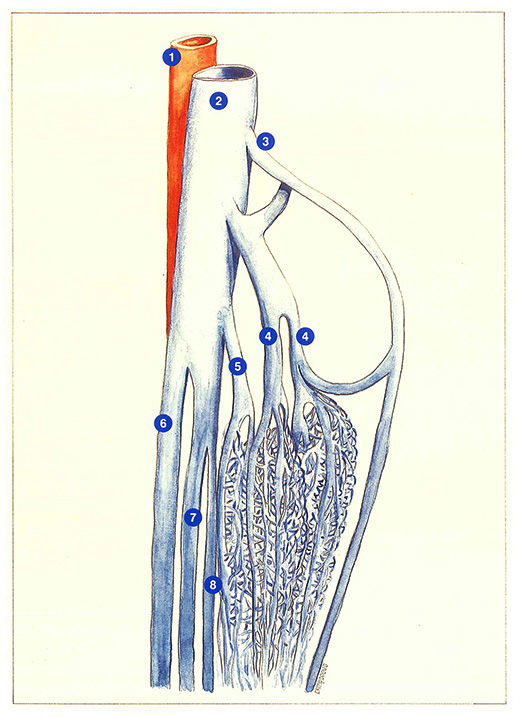Anatomical aspects
Examination of the muscular-venous network of the calf allows a better understanding of venous disease, as this constitutes the site of intimate relationships which involve the five components of venous hemodynamics: intravenous pressure, venous wall, valves, perivenous muscle, and muscle fascia. Clearly functional anatomy is particularly important in this context.
The calf is a large muscle mass made up of the triceps surae muscle, composed of two planes: a superficial plane, comprising the medial and lateral heads of the gastrocnemius muscle: and a deep plane, corresponding to the soleus muscle. These muscles, inserted in the distal part of the femur, fuse inferiorly to form the tendo calcaneus.
Le mollet représente une importante masse musculaire correspondant au muscle triceps sural. Celui-ci comporte deux plans : l’un superficiel, les muscles jumeaux interne et externe, l’autre profond, le muscle soléaire. Issus de la partie distale du fémur, ces muscles se rejoignent en bas pour former le tendon d’Achille.
The gastrocnemius veins are situated within the medial and lateral gastrocnemius muscles (Figure 73). Lateral gastrocnemius veins have a much smaller caliber than medial gastrocnemius veins. A dense intramuscular venous plexus unites to form a common extramuscular trunk which travels for I to 4 cm in the loose adipose connective tissue of the popliteal fossa.
This common extramuscular trunk of the gastrocnemius muscle terminates:
- directly in the popliteal vein, very obliquely, forming an acute angle, almost vertically above the popliteal vein; this allows the gastrocnemius veins to ensure a shock-absorbing role in the case of sudden pressure variations in the popliteal vein;
- in the saphenopopliteal junction at the level of the concavity of the short saphenous vein: this type of termination makes saphenopopliteal junction ligation flush with the popliteal vein more difficult; or
- simultaneously in the popliteal vein and short saphenous vein via a lambda-shaped termination.

In the popliteal fossa, the gastrocnemius veins and short saphenous veins have a different macroscopic appearance. The gastrocnemius veins are bluish and have a fine, poorly muscular, but highly elastic wall. In contrast. the short saphenous vein, situated more superficially, retains the pearly appearance of veins of the subcutaneous plexus.
The intramuscular gastrocnemius veins form a dense venous plexus, which branches and anastomoses within the mass of muscle tissue (Figure 74).
In the lower part of the calf, one of the largest branches emerges from the medial gastrocnemius muscle, where the muscle mass gives way to membranous tissue, this constitutes the gastrocnemius perforating vein or Gillot’s lower pole perforating vein(see Figures 93 and 100).
The soleus veins are situated in a deeper muscle plane. They unite to form one or several main trunks, which terminate in either the posterior tibia vein or the peroneal vein. In contrast with the gastrocnemius veins, their extramuscular portion is very short. However. like the gastrocnemius veins, they receive a perforating vein at the lower pole of the muscle, which communicates with the gastrocnemius venous plexus or directly with the short saphenous superficial network.

The general arrangement of the intramuscular plexus of soleus veins is variable. It can be predominantly vertical and terminate via a single common trunk in the posterior tibial or peroneal network, or it can be predominantly horizontal and comprise an anastomosis with the posterior tibial or peroneal network via multiple intramuscular arches at different levels.
Further reading
Daniel C. Le syndrome des veines jumelles. Actualité Vasculaire Internationale, 1992; 6 : 16-22.
Gillot C. La perforante polaire inférieure du muscle jumeau interne. Phlébologie, Édition Médicale Média Internationale, Congrès de Bruxelles, vol 1, 1983.
Thierry L. Physiology of the muscular veins. Phlébologie, Éditions John Libbey Eurotext, Montréal 1992.
Van der Stricht J. Staelens I. Les veines musculaires du mollet. Phlébologie 1994; 47, 2: 135-43.

